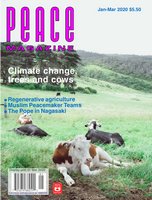DESPITE PUTIN’S OFFER, U.S. STILL REFUSES TO EXTEND NEW START TREATY
On December 5, Russian President Vladimir Putin offered to extend the New Strategic Arms Reduction Treaty (New START) “with out preconditions.” The treaty, which entered into force in 2011, is set to expire in February 2021. Putin said, “Russia is willing to immediately, as soon as possible, before the year is out, renew this treaty without any preconditions.” He continued, “I am stating this officially so that there are no double or triple interpretations of our position later.”
The United States has indicated that it wants to bring China into any future arms reduction treaty, even though the U.S. and Russia continue to possess over 90% of all nuclear weapons in the world.
Source: Ankit Panda, “Putin: Russia Ready to Extend New START With U.S. ‘Without Any Preconditions’,” The Diplomat, December 6, 2019. Via The Sunflower, Dec. 2019
GERMANY HAS NO SOLUTION FOR ITS NUCLEAR WASTE
Due to increasing safety concerns, Germany has decided to shut down all of its nuclear power plants by the year 2022. One of the biggest challenges Germany faces is where to safely bury lethal radioactive waste for the next million years. High-level nuclear waste needs to be buried at least 1 kilometre underground and in a location that is geologically stable.
Politicians have discussed building nuclear facilities in the village of Gorleben, but public opposition to burying toxic waste in their community has necessitated the search for an alternative nuclear graveyard. Communicating the danger of these nuclear waste sites to future generations is an additional challenge that communication experts are currently working on.
Source: Sheena McKenzie, “Germany Is Closing All Its Nuclear Power Plants,” CNN, November 30, 2019. Via The Sunflower, Dec. 2019.
AMERICANS UPSET BY CANADA’S PLAN TO STORE NUCLEAR WASTE BY LAKE HURON
Back in 2002, parliament established a body, the Nuclear Waste Management Organization (NWMO), which consists of the nuclear power generating companies in Quebec, Ontario, and New Brunswick. The organization was mandated to devise a plan for storing Canada’s nuclear fuel over the long term—perhaps the next few million years. Finally, their plan is beginning to firm up as they narrow the list of five potential burial sites down to a short list of two.
One of these is quite remote—at Ignace, a town about 150 miles north of Lake Superior. However, our American neighbours are not all pleased with the other preferred option. This site is at Huron-Kinloss/South Bruce County. That location is close to Bruce Power, Canada’s largest Nuclear Generating Station—actually, the largest nuclear power plant in the world.
The nuclear waste has been accumulating for many years from Ontario’s 19 reactors, and now there are nearly three million of these bundles, all still kept above ground at the reactors, either in solid containers or in cooling pools. The new plan is to create a large repository, down about 1650 feet inside a stable rock formation. This Lake Huron site had already been identified several years ago as a good burial location for low-to-intermediate level waste. However, even then, some of the neighbours in Michigan objected to the proposal, and now they are even more opposed.
Of course, the United States is no further ahead than Canada in its quest for a permanent repository. Perhaps the most advanced country in this regard is Finland, which is quite far along in constructing a granite tomb on the Gulf of Bothnia There it will bury nearly 3,000 sealed copper canisters, each up to 17 feet long and containing about two tons of spent reactor fuel. There will eventually be about twenty miles of tunnels, which after being filled with these canisters, will be packed with clay and abandoned forever.
The US planned for a site at Yucca Mountain in Nevada, but this still meets strong resistance. Several congressional representatives have written to Prime Minister Trudeau, insisting that Canada should “protect these waters for future generations.” The House Energy and Com added that no storage of spent fuel should be allowed near the Great Lakes.
Source: Darrell Proctor. “Canada Plan Draws U.S. Ire” Dec. 9, 2019 Power. www.powermag. com/canada-plan-to-storenuclear-waste-near-lakehuron-draws-u-s-ire/ and Henry Fountain, “On Nuclear Waste, Finland Shows U.S. How It Can Be Done”, The New York Times, June 9, 2017.




Commenting is closed for this article.